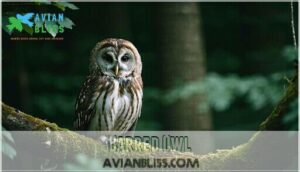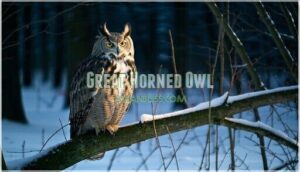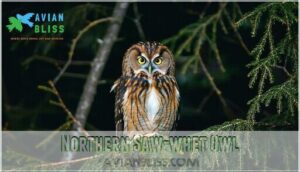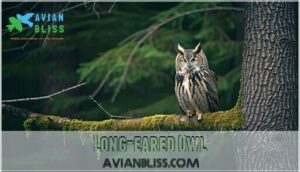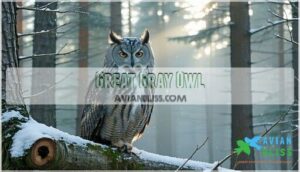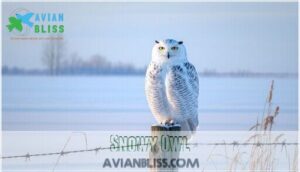This site is supported by our readers. We may earn a commission, at no cost to you, if you purchase through links.
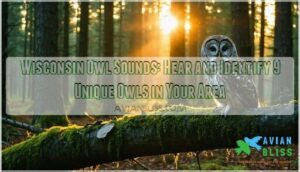
The Barred Owl’s unmistakable "**Who cooks for you?
**" dominates wooded areas, while Great Horned Owls deliver deep, resonant hoots that carry for miles.
Eastern Screech Owls produce haunting trills and whinnies, and Northern Saw-whet Owls repeat monotonous tooting sounds.
Wisconsin hosts nine species total, from the tiny saw-whet to massive Great Gray Owls that visit during winter.
Each species uses unique vocalizations – some screech, others hoot, trill, or even bark, and Learning these wisconsin owl sounds transforms evening walks into identification adventures, especially when you discover which calls signal breeding season versus territorial disputes.
Table Of Contents
Key Takeaways
- You’ll be able to recognize Wisconsin owl sounds by their distinctive calls, such as the Great Horned Owl‘s deep "who-who-who" hoots and the Barred Owl’s "Who cooks for you?" calls, which will help you identify the different species.
- By learning these sounds, you’ll enhance your outdoor experiences, as you’ll be able to distinguish between breeding season calls and territorial disputes, and even identify the time of day when owls are most active.
- You’ll discover that different owl species have unique vocalizations, such as hoots, screeches, whistles, trills, barks, and clicks, which are used for communication, mating, and defending territories.
- As you explore Wisconsin’s forests and fields, you’ll find that understanding owl sounds will transform your evening walks into engaging adventures, allowing you to connect with nature and appreciate the importance of owls in the ecosystem.
Barred Owl
If you spend a quiet night in Wisconsin’s forests, you might hear the Barred Owl’s booming “Who cooks for you?” echo through the trees.
Listen for the Barred Owl’s haunting who cooks for you call in Wisconsin’s forests
These owls are masters of camouflage techniques, blending into the shadows with brown eyes and vertical white barring. Barred Owl calls are a reliable way to identify this species among wisconsin owl sounds, especially during breeding season when male and female vocalizations overlap in a natural duet.
Living in mature woods and swamps, they favor tree cavities for owl nesting, often recycling old nests. Their diet covers small mammals and amphibians—think of them as the forests’ natural pest controllers, key to forest ecology.
Conserving habitats where they thrive helps you’ll keep hearing these unique owl vocalizations among nocturnal bird sounds for years to come. Understanding their role in nocturnal hunting techniques is vital for appreciating the importance of owls in the ecosystem.
Great Horned Owl
At night, you’ll hear the Great Horned Owl’s deep hooting call echoing through Wisconsin forests.
This skilled nocturnal predator boasts excellent low-light vision, silent flight, and acute hearing, making it a formidable hunter.
Its diet includes rabbits, skunks, and geese.
The Great Horned Owl’s habitat ranges from forests to urban areas, and it’s known for its owl vocalizations, including nighttime hoots.
With its silent flight and sharp talons, it’s a master of owl hunting tactics.
The Great Horned Owl’s nesting habits involve claiming prime habitat, typically tree cavities or abandoned raptor nests, showcasing its unique owl nesting behavior in Wisconsin’s owl sounds landscape.
The Great Horned Owl’s adaptability to various environments is a key factor in its success as an owl silent hunter.
Eastern Screech Owl
A master of blending in, the Eastern Screech Owl makes itself known through its signature tremolo screech calls as dusk falls over southern Wisconsin.
You’ll spot these tiny owls nesting in tree cavities or backyard boxes, quietly hunting insects and rodents. They thrive in urban Forest Habitat, sporting either red or gray feathers for perfect Owl Nesting camouflage.
Listen for their bouncing-ball nocturnal owl calls—one of the most distinctive wisconsin owl sounds. The Western Screech-Owl exhibits unique nocturnal activity patterns.
- Distinct screeching accelerates like a pinball
- Versatile owl diet
- Hidden in plain sight
Northern Saw-whet Owl
The Northern Saw-whet Owl ranks as North America’s smallest owl species, yet don’t let its size fool you. This pint-sized predator packs serious hunting skills into its seven-inch frame.
Meet the tiny but fierce Northern Saw-whet Owl, a pint-sized predator with big hunting skills.
You’ll find these forest owls throughout Wisconsin’s dense coniferous and mixed woodlands, where they master the art of staying hidden. Listen for their distinctive saw whet calls after dark – a repetitive "too-too-too" that sounds like someone sharpening a saw blade.
These wisconsin owl sounds carry through the night air during their nocturnal hunting sessions, when they target deer mice and other small mammals with laser-like precision. Owl habitat preferences include dense thickets at eye level, where they roost in tree cavities or abandoned woodpecker holes.
During owl migration periods, you might spot these elusive creatures more frequently as they move through Wisconsin’s forests. Their nighttime hoots and nocturnal owl calls create an almost mechanical rhythm that’s unmistakable once you learn it.
Though they’re masters of camouflage, their piercing yellow eyes and rust-colored feathers with distinctive Y-shaped facial markings make identification easier when you do catch a glimpse. The Northern Saw-whet Owl’s breeding habits involve using tree cavity nests to raise their young, making them a unique species to study.
Long-eared Owl
Out among the dense spruces and pines of Wisconsin, you’ll need sharp eyes—and perhaps sharper ears—to spot the Long-eared Owl. This Longeared Owl’s secretive life is a masterclass in blending in.
By day, it roosts deep in conifers. At night, it floats silently, hunting with stealth. Listen for those low, two-note hoots—classic wisconsin owl sounds for this species.
Here’s what to look for:
- Dense Long Eared Habitat
- Remarkable Silent Flight
- Strictly Nocturnal Behavior
- Unique Owl Migration habits
- Reusing abandoned nests (Nesting Patterns)
Understanding the owl’s habitat preferences can aid in spotting these birds, particularly in their natural habitats with strictly nocturnal behaviors and unique migration patterns.
Barn Owl
Your Barn Owl encounter will be memorable, thanks to its eerie, screeching song.
| Characteristic | Behavior | Habitat |
|---|---|---|
| Pale face | Expert hunter | Open fields |
| Heart-shaped disk | Cavity nester | Barns, trees |
| Long wings | Rodent predator | Mixed farmland |
As you explore Wisconsin’s southern regions, you’ll discover the Barn Owl’s adaptability to open habitats.
Its keen hearing enables silent flight, making it an efficient hunter of voles and mice.
By understanding Barn Owl habitat, owl nesting, and Barn Owl diet, you’ll appreciate the importance of owl conservation, especially in preserving Wisconsin’s bird population, including the Barn Owl, and its unique owl sounds.
The Barn Owl’s nocturnal lifestyle is characterized by silent flight patterns, which contribute to its success as a predator.
Short-eared Owl
You’re now exploring the Short-eared Owl, a bird that thrives in Wisconsin’s open meadows and marshes. This owl’s hunting tactics are unique, as it flies during the day, showcasing its tawny plumage and bat-like flight.
Here are 5 fascinating facts about the Short-eared Owl:
- Daytime flying allows it to hunt effectively
- It builds its own nests on bare ground
- The owl lays large clutches of up to 11 eggs
- Both parents incubate eggs and feed young
- It migrates south in winter when prey is scarce, affecting Wisconsin owl sounds and owl calls.
Witnessing this owl’s daytime hunting is a treat for birders, making it a notable part of Wisconsin birds and owl sounds. The Short-eared Owl’s preferred open habitat characteristics play a vital role in its survival and hunting success.
Great Gray Owl
You’re now exploring the Great Gray Owl, a prized sighting in Wisconsin.
This owl’s territorial hooting is a treat, especially during irruptive winters when they stray south. With asymmetrical ears and a silent flight, Great Grays expertly snatch rodents.
Habitat loss affects their population, but they adapt well to Wisconsin’s northern forests. As you listen to Wisconsin owl sounds, notice the Great Gray’s distinctive call.
Their Arctic adaptation and camouflage enable them to thrive. Look for them in mature forests or remote swamps before dawn, and appreciate their role in balancing Wisconsin’s ecosystems, making them a unique part of Wisconsin birds.
The Great Gray Owl’s survival depends on effective conservation efforts, which is crucial for their well-being in the northern forests and remote swamps, ensuring the balance of ecosystems.
Snowy Owl
You’re now exploring the Snowy Owl, a rare winter visitor to Wisconsin. This large, white owl boasts Snowy feathers and a distinctive hooting call.
Its Arctic habitat influences its Owl Migration patterns, often heading south when lemming populations decline.
- Irruptive migrations occur when food is scarce.
- Diurnal activity sets it apart from other owls.
- Vole diet supplements its lemming diet in Wisconsin.
Observe its Winter Behavior, scanning open areas for prey, and appreciate the magic of this Arctic visitor, contributing to Snowy Owl research and conservation, while enjoying Wisconsin owl sounds and wildlife.
Understanding the northern hawk owl’s habitat loss factors can also provide insights into the broader ecosystem of owls in the region.
Frequently Asked Questions (FAQs)
What do owls in Wisconsin sound like?
Like old-timey telegraph operators tapping out messages, you’ll hear Wisconsin owls produce distinctive calls.
Great Horned Owls deliver deep "who-who-who" hoots, while Barred Owls ask "Who cooks for you?"
Eastern Screech-Owls create eerie whinnying sounds, and Northern Saw-whets make repetitive "too-too-too" notes.
What is the most common owl in Wisconsin?
The Great Horned Owl stands as Wisconsin’s most common year-round resident.
You’ll find these adaptable hunters thriving in forests, farms, and even urban neighborhoods, making their distinctive "who-who-who" calls a familiar soundtrack across the state, with the Great Horned Owl being a notable example.
What are the six sounds of an owl?
Wisconsin’s 11 owl species produce six distinct vocalizations: hoots, screeches, whistles, trills, barks, and clicks.
You’ll hear Great Horned Owls‘ deep hoots, Barn Owls’ harsh screeches, and Northern Saw-whet Owls’ repetitive toots echoing through forests.
What owl makes a hoo hoo sound?
You’ll recognize the classic "hoo hoo" sound from Great Horned Owls, whose deep territorial hoots echo through Wisconsin forests year-round.
Barred Owls are famous for their "**Who cooks for you?
**" calls.
What time of day do owls hunt?
Most owls hunt at night when their exceptional hearing and silent flight give them advantages.
Though you’ll spot Great Horned, Short-eared, Snowy, and Northern Hawk owls hunting during daylight hours too.
How far can owl calls travel?
Picture the haunting hoot echoing through midnight forests – your owl’s call can travel up to two miles on still nights.
Wind, humidity, and terrain affect distance, but most species’ territorial songs reach roughly half a mile under typical conditions, with the call being a key factor in determining the distance.
Why do owls hoot at night?
You’ll hear owls hooting at night because they’re primarily nocturnal hunters communicating with mates, defending territories, and coordinating family activities when their prey is most active and vulnerable.
Can owls mimic other bird sounds?
Like a master impressionist at nature’s theater, you’ll find that most owl species can’t actually mimic other birds’ sounds.
They’re built for their own signature calls—hoots, screeches, and whistles—rather than copying their feathered neighbors’ vocal repertoires.
Do baby owls make different sounds?
You’ll discover that baby owls make high-pitched cheeping or chirping sounds, distinct from their parents’ hooting or screeching vocalizations, as they develop and learn to communicate effectively.
Conclusion
Now you’re equipped to distinguish between Wisconsin’s unique owl species.
By learning wisconsin owl sounds, you’ll enhance your outdoor experiences, identifying breeding season calls versus territorial disputes, and more, with each species’ distinct vocalizations, from screeches to hoots, transforming your evening walks into engaging adventures.
- https://dnr.wi.gov/topic/EndangeredResources/Animals.asp?mode=detail&SpecCode=ABNSB13040
- http://langelliott.com/audubon-bird-songs/
- https://issuu.com/wisconsinnaturalresources/docs/dnrmagazine_winter2024_issuu-printquality_singlepa/s/62522029
- https://www.schlitzaudubon.org/2020/11/09/owls-in-wisconsin/

